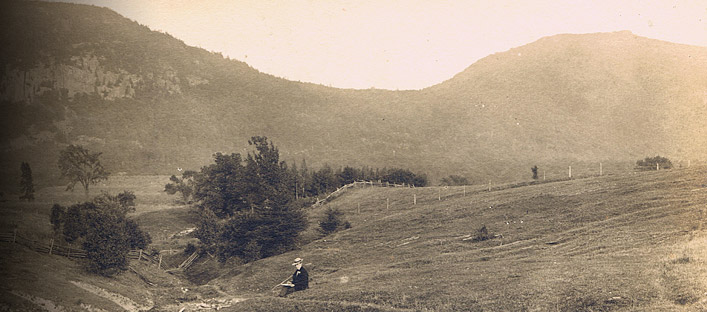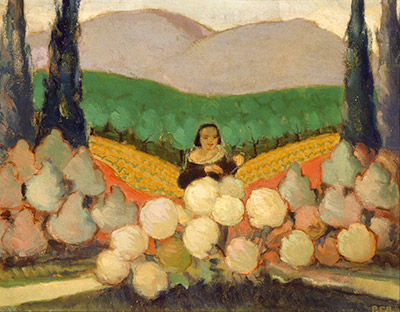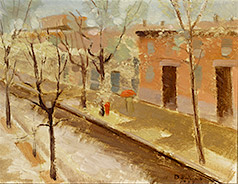In the House of Paul-Émile Borduas

A Cherished Mountain
The Changing Seasons

Paul-Émile Borduas, Synthesis of a landscape of Saint-Hilaire, 1932,
oil on canvas. Private collection.
Photo MBAM, Christine Guest et Brian Merrett.
© Paul-Émile Borduas Estate / SODRAC (2013) Paul-Émile Borduas built his house on the banks of the Richelieu River, near the village of Saint-Hilaire, his hometown, between 1940 and 1942. The house is first used as a summer residence from 1942 to 1945, since the Borduas still live in Montreal. In 1945 they move to Saint-Hilaire permanently until 1952. By moving there, the artist gave his children, Janine, Renée and Paul, the privilege of growing up close to nature in an enchanting, peaceful environment.
The family’s activities followed the rhythm of the seasons. In summer, the river sang its siren song. During vacations, there were rowboat outings that gave Borduas a chance to get closer to his children. Walks on the mountain were a pretext for calling on the mountain “sage,” Ozias Leduc. Discovering the story of the “Grotte des fées” (fairies’ cave) and other legends associated with Mount Saint-Hilaire added spice to the family walks.
After his departure for New York in 1953, Borduas wrote to his daughter Janine:
«The ice has formed on the river.
White immobility will reign until spring.
In just a few days there’ll be a couple of big snowfalls – and it will be time when we, the divinely four of us, go to slide on the mountain …
Excuse me for bringing back this “present” that may be somewhat distant for you. It’s my way of dealing with the memory of some of my happiest days.»
For Borduas, the changing seasons that shaped activities on the mountain and river remained forever linked to the memory and very essence of family life throughout the yearly cycle.
In 1942, in a text taken from “Au printemps dernier” (Last spring), a variant and draft version of an article entitled “Manières de goûter une oeuvre d’art” (Ways of savouring a work of art), published in January 1943 in the review Amérique française, as well as being part of a lecture given before the Société d’étude et de conférences on November 10, 1942, Borduas writes :«A magnificent summer opened up in my immediate future. I would have all the time I needed to prepare myself – that’s what I thought I would do as I set out to conquer the beauty of nature. The countryside awaited me, with its thousands of incomparable lessons. Relieved of citified burdens, I let myself be penetrated by light… Slowly baking under the radiant suns of summer, I hoped to be perfectly done by November. In my rapture, I mixed up everything, to the point of preferring this light to intellectual illumination anywhere. From one depravity to another, I let myself go so far that I even preferred contemplating the objective beauty of all things to contemplating abstract beauty or ideal beauty.
In this extreme forgetfulness, fine days and less fine days passed, without doubting my working method for a single moment.»
Header image: A stunning view of the mountain (SHBMS, Gustave Roy collection).

Paul-Émile Borduas, Spring morning, 1937, oil on canvas. Private collection. Photo MBAM, Christine Guest et Brian Merrett
© Paul-Émile Borduas Estate /
SODRAC (2013)
«Leduc is the mature fruit of three centuries of isolation in this North American land: a fruit that has ripened – one is not sure how – at the foot of its mountain.»
«The countryside is magnificent this morning. To truly appreciate the landscape of the Richelieu Valley, you have to come here in late spring, not in mid-summer.»
«It’s still as fine and warm as the end of May at our place.»
© Musée des beaux-arts de Mont-Saint-Hilaire, 2014.
All rights reserved.

